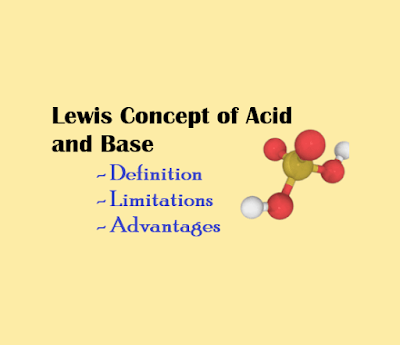Lewis Concept of Acid and Base
Lewis Acid: According
to Lewis Concept, an acid is clearly defined as the substance which can accept
a pair of non-bonding electrons. They are clearly known as an electrophile. They
consist of vacant orbitals in their molecular structures. Ag+, Cu++ and Fe+++ are the few examples
of acid according to Lewis concept.
There are various elements
found which can act as Lewis acids. From the definition of Lewis acid, it is
clearly known that all cations are Lewis acids since they are able to accept
the pair of an electron (Cu2+, Fe2+, Fe3+). Also, an ion, molecule, or an atom which is with an incomplete octet of electrons can act as a Lewis
acid.
Lewis Base: According
to Lewis Concept, the base is defined as the substance which can donate the pair
of non-bonding electrons. They are clearly known as a nucleophile. They consist
of a lone-pair of electrons in their molecular structures. Cl- and OH- is
an example of the base according to Lewis's concept.
Lewis Bases are nucleophilic
substances which means they attack a positive charge of another atom with their
lone pair of electrons. Also, an ion, molecule or an atom which are with lone-pair
of an electron can act as a Lewis Base.
Lewis Neutralization Reaction: According to the Lewis Concept, neutralization reactions
defined as the reaction in which the base donates the line pair of an electron to
the acids.
NH3 +
BF3 → H3 → BF3
Advantages of Lewis Concept of Acid and Base:
- It
can explain the acidic nature of carbon dioxide (CO2) AND AlCl3.
- It
can explain the reaction in which proton is not involved.
- It
can share the pair of an electron with no change in the oxidation numbers.
- It
complements the method of the oxidation-reduction method. Oxidation and reduction
reactions method consists of a transfer of electrons from one atom to another atom
with a change in the oxidation number of one or more than one atoms.
Limitations of Lewis Concept of Acid and Base:
- In this concept, all acid-base reactions do not involve co-ordinate
bond information.
- This theory completely fails to explain the relative
strength of acids and bases.
- It fails to explain why the acid-base reactions are faster
although a co-ordinate covalent bond is formed.
- According to Lewis Concept, the acid reacts with a base to form a co-ordinate covalent compound. But in the case of HCL and NaOH, the ionic bond
is formed.
- It fails to explain the relative strength of acids and
bases.
If you really enjoyed reading then feel free to check our latest blog, My Favorite Game Essay in English
If there are any other topics that you're confused about then you can suggest to us about it in the comment section so that we can clear your doubts easily.
If you really enjoyed reading then feel free to check our latest blog, My Favorite Game Essay in English
If there are any other topics that you're confused about then you can suggest to us about it in the comment section so that we can clear your doubts easily.




thank you so much for the questions
ReplyDeleteThank u for this notes
ReplyDeleteThank u for your notes
ReplyDeleteThankuu
ReplyDelete